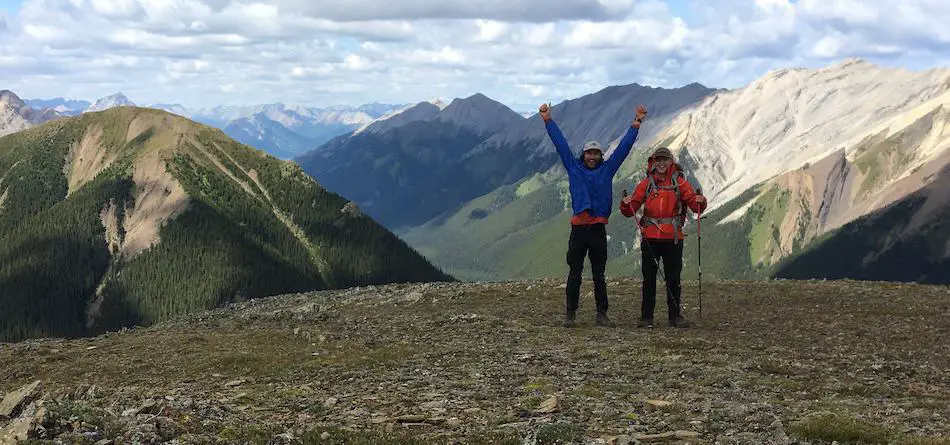
Having the right gear is essential when climbing mountains. I created the following guide to help you dress for your next mountain climbing adventure!
So, what do you want to wear when mountain climbing? For mountain climbing, you want clothes that are lightweight, breathable, and have a high degree of mobility. You should avoid wool or denim at all costs.
Much like in hiking, mountain climbing clothes need to be flexible enough to allow you to move and light enough to prevent you from sweating as much as possible. However, you also want to make sure that you pack enough layers to keep you warm, dry, and safe; conditions can change rapidly in the mountains, and having protection from the elements can be the difference between life and death. In this guide, I break down some broad considerations for your mountain climbing clothes, as well as give my own specific recommendations for what you should wear!
Mountain Climbing Clothes
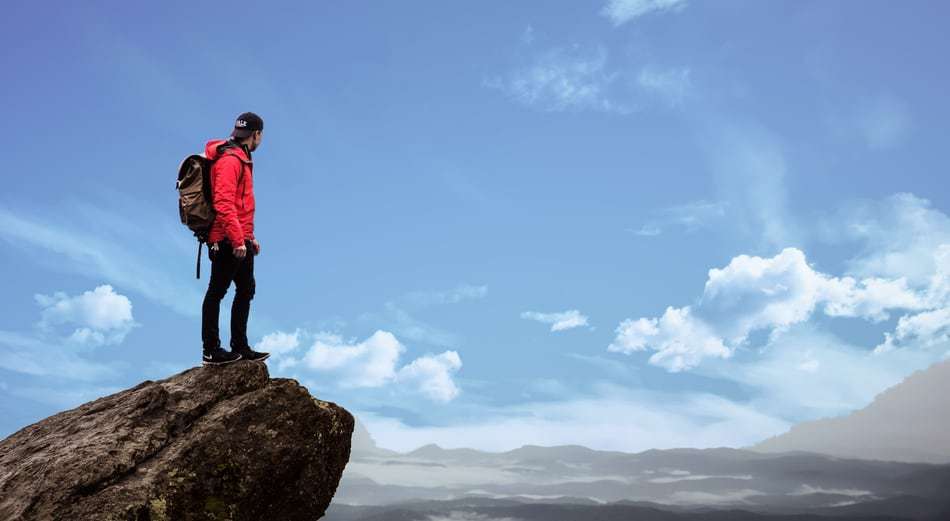
When mountain climbing, you want to bring (at minimum) the following:
- A shirt that is breathable, and quick drying.
- A sweater that is light enough for you to move around in
- A fleece or jacket that can keep you warm when you stop moving
- A comfortable pair of pants that allow for a full range of mobility
- Good socks, preferably made out of merino wool
- Shoes or boots that have good traction
- A hat to keep the sun off of your face
- Rain Gear in case the weather turns
I’ve climbed dozens of mountains in my life, and I’ve slowly refined the list of what I wear to find the most comfortable and practical combination that works for me. Using that experience, I’ve been able to build the above list.
The goal when dressing for mountain comfort is make sure that you’re comfortable and prepared. The comfort element is mostly in regard to what fabrics you are wearing, as some clothes work better for mountain climbing than others. For example, denim is an extremely heavy material that isn’t very flexible; wearing denim pants on a hike is a bad idea. Similarly, cotton doesn’t breathe and retains a lot of moisture, so you’ll quickly find yourself soaked with sweat if you wear cotton.
Instead, I would recommend either wool or synthetic fabrics. Synthetics have come a long way in the past few years in terms of their effectiveness and affordability; nowadays, you can almost always find synthetic clothing that is stretchy, lightweight, and quick to dry.
These types of clothes are highly desirable, because they give you everything you need to climb a mountain:
- A full range of motion so that you can move through challenging terrain
- Enough breathability to minimize your sweating (walking around in sweaty clothes for hours is super uncomfortable)
- The knowledge that, when they do get wet, they’ll dry off quickly. This means that your clothes won’t stay sweaty forever, and that if they get soaked (by rain/a river crossing/any other water), they’re going to dry by the time you reach the summit.
The preparedness part is concerned with having enough layers to be ready for whatever mother nature throws at you. Speaking from experience, I can say that you never know what kind of weather you’re going to get in the mountains. I’ve had days where it’s been sunny when I’ve started climbing, and by the time I get to the top it’s hailing; likewise, I’ve had days where it looked like it was going to rain, but the weather ended up being gorgeous. I’ve had to contend with snow in the middle of summer and hundred-mile-an-hour winds.
Because of this, you need to have enough clothing to be prepared for any outcome. Doing so isn’t just a matter of comfort; it can actually save your life. Hypothermia and other injuries relating to exposure are serious threats in the mountain, and without proper clothing or shelter from the elements, you likely only have three hours to survive in extreme conditions.
The real trick is balancing these two factors. You need to have little enough clothing to be lightweight and comfortable, but still enough that you can stay warm in harsh conditions. To achieve this, you want to use something called layering.
Layering
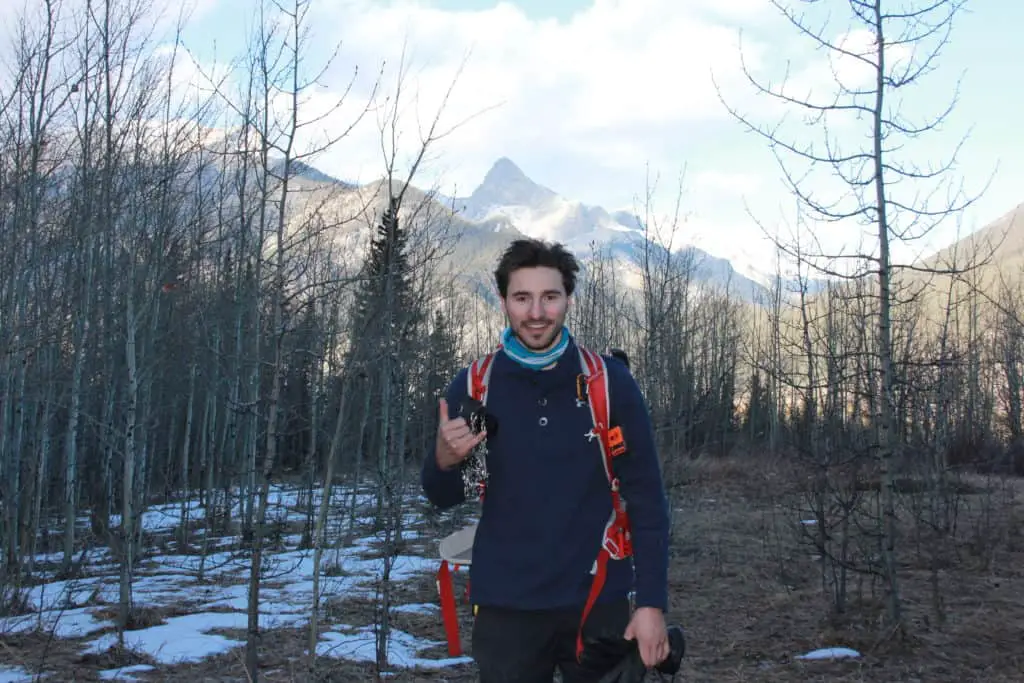
Layering is, as the name might suggest, when you bring multiple pieces of clothing, each of them a different level of warmth/protection. This allows you to put on and take off layers as you see fit.
For an example of how this goes, let me demonstrate how my layering usually changes throughout the day when I’m climbing a mountain:
- In the morning when it’s cold, I’ll often put a light sweater on for the approach
- By mid-morning, I’ve usually started hiking uphill, and it’s starting to heat up. I’ll take the light sweater off, so I’m hiking in just a t-shirt.
- After a few hours, I reach the summit, where it’s extremely windy. Because of the wind and the fact that I’m no longer exerting myself walking uphill, I put on a warm jacket over top of my t-shirt.
- On the descent, the temperature is starting to drop and I’m not working as hard, so I’ll put my light sweater on again.
Here, you can see how having multiple layers allows me to be properly dressed no matter what the conditions are. If it gets cold or I stop moving, I layer up; once it gets warmer or I start exerting a lot of effort, I layer down to avoid sweating and stay comfortable. In the guide below, I give some specific recommendations for what different layers you should be bringing with you.
Pro tip: Layering is effective, but not 100% of the time. There are some situations where you’re little too cold, but if you layer up, you’re going to be a little too hot. In these scenarios, you have to simply deal with being a tad bit uncomfortable. Trying to carry enough layers to keep you the perfect temperature in every situation will simply add too much weight to your pack.
Mountain Climbing vs Mountaineering Clothes
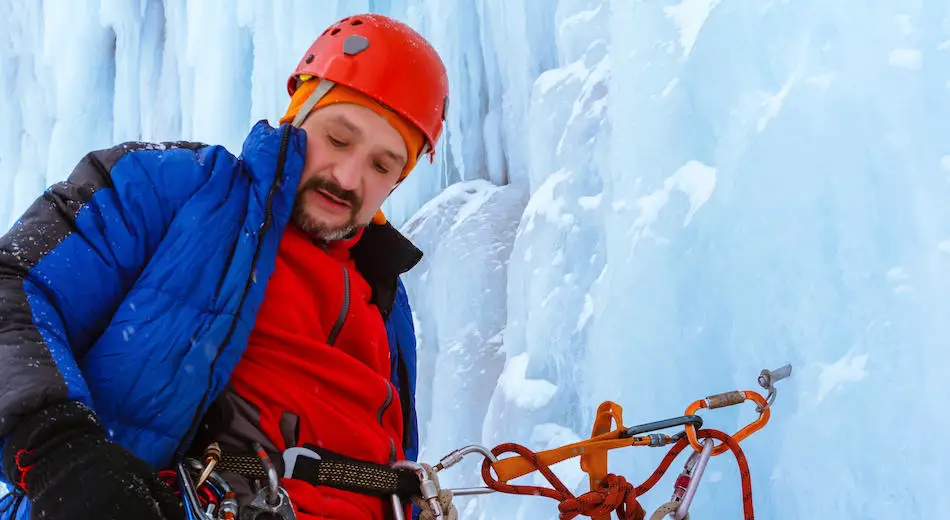
Something important to consider when reading this list is the differences between mountain climbing and mountaineering.
From what I’ve been able to see, most of the guides on the internet revolve around mountaineering, which is an activity in which you scale technically difficult peaks, often in winter conditions. Dressing for mountaineering usually involves lots of high-tech, expensive down clothing.
This guide is instead focused on mountain climbing in general — that is, the art of getting to the top of a mountain. Mountain climbing usually occurs in the summer, spring, or fall, and it doesn’t involve the same extreme temperatures. Because of this, the clothes I recommend in this guide are a lot less technical and a lot more oriented towards mild temperatures. If you’re going on a technical mountaineering expedition — that is, one in which you have an axe, crampons, and a rope — I would recommend looking at one of the other guides available online!
So, with all of that established, let’s take a look at what you want to wear while mountain climbing! I’ve broken the guide up based on body part.
Upper Body
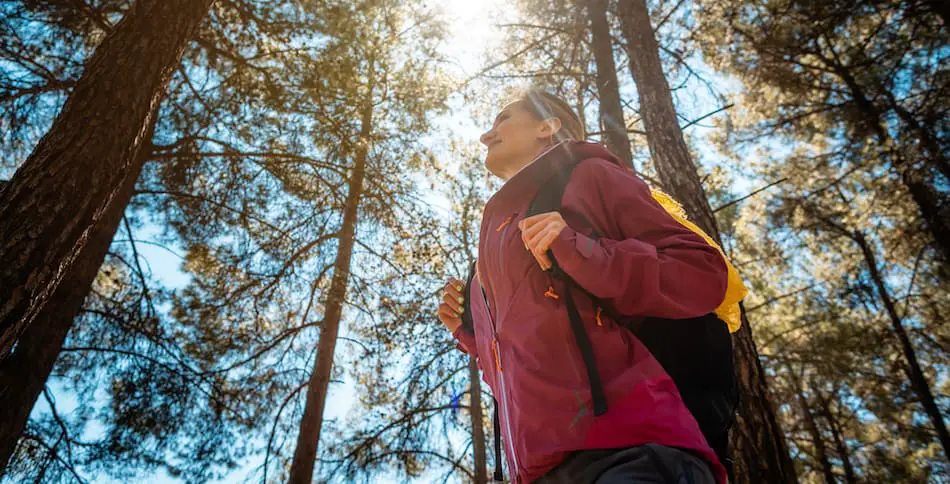
Your upper body is where the majority of your layering takes place when you’re mountain climbing. Because of this, it’s important that you bring a variety of different options with you so that you can stay warm no matter what happens.
For three-season mountain climbing (spring, summer, and fall), I would recommend three different layers:
- A base layer
- A mid layer
- A non-active layer
If you’re going mountain climbing in the winter, I would recommend bringing something called an active mid layer, which I’ll explain in more detail below.
Base layer
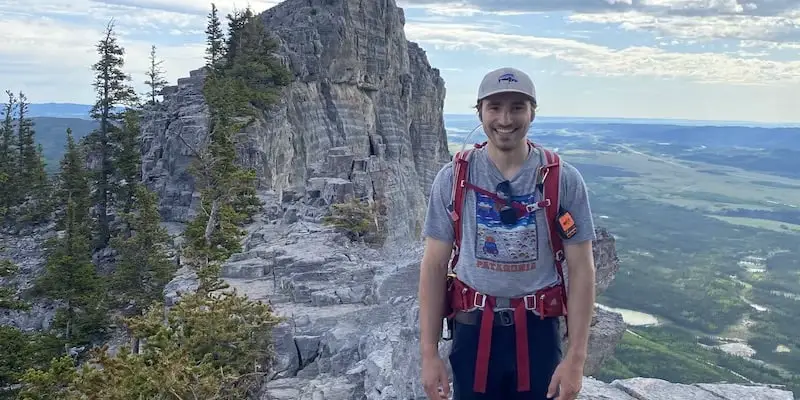
A base layer is, as the name suggests, a layer that you put on that everything else goes over top of. Another way of thinking about it is that your base layer never comes off; because of this, you want to ensure that it’s lightweight enough that you can wear it no matter how hot it gets.
I personally prefer a simple t-shirt when I’m mountain climbing. Long-sleeve shirts can also work well, especially if you’re in an area that has lots of bugs or if you’re sensitive to the sun.
In terms of material, the main thing to look for is comfort and breathability. Your shirt is almost certainly going to get sweaty (especially on the back, where your backpack pressed against your skin), so you want a shirt that’s going to help keep you cool as much as possible. Another thing to pay attention to is the cut of the shirt. Some shirts will have seams along the back that, if you’re wearing a heavy backpack, could become irritating throughout the day.
If you’re looking to save some money, any old workout or athletic shirt will do for this layer. The first year or two that I went mountain climbing, I mostly wore old gym shirts or ones that I had bought at Winners.
If you’re looking for a bit of an upgrade, though, I would personally recommend the Patagonia Capilene Cool shirt (which I’m wearing in the above photo, and also while I sit at my desk writing this guide. I seriously love them). These shirts are incredibly comfortable, super lightweight, and insanely breathable. They dry quickly, last a long time, and have awesome designs on the front of them. Do yourself a favour and buy one immediately.
In lieu of a Patagonia Capilene Cool, other brands like The North Face, Mountain Hardwear, Columbia, and Arc’teryx will have lots of options.
Mid Layer
When mountain climbing, a mid layer is usually worn in two scenarios:
- When you’re walking but not exerting a lot of energy and it’s fairly cool outside
- When it’s kind of cold outside and you’re resting (not exerting any effort)
So, you either need the mid layer to keep you kind of warm when walking, or decently warm when you’re standing still. Because of this, mid layers need to toe the line between breathability and insulation.
Many of the companies that I mentioned above will have options for mid layers. A few standout pieces include:
- The Patagonia R1 (on the warmer end for 3-season adventures)
- The Mountain Hardwear Airmesh might be better suited for summertime hikes
- The Mountain Hardwear Ghee Hoody
If you don’t want to cough up $100 for a high-technology mid layer, any lightweight sweater or crewneck will do (especially if you’re just getting into the sport). When choosing a sweater, do your best to avoid cotton, and try to pick something that seems like it will dry decently quickly.
Once you’re ready for an upgrade, though, a dedicated mid layer can really help you be comfortable when mountain climbing. There are a couple of things you should consider when you’re looking to buy one:
- How warm is it? Many companies will sell you mid layers that are designed for technical mountaineering or even backcountry skiing. These pieces will be too warm for summer mountain climbing.
- How adaptable is it? Remember, you want your mid layer to be able to keep you warm, but not too warm once you start moving. Things like deep chest zippers and sleeves that are loose enough to be rolled up really help your sweater adapt once you start moving.
Non-Active Layer
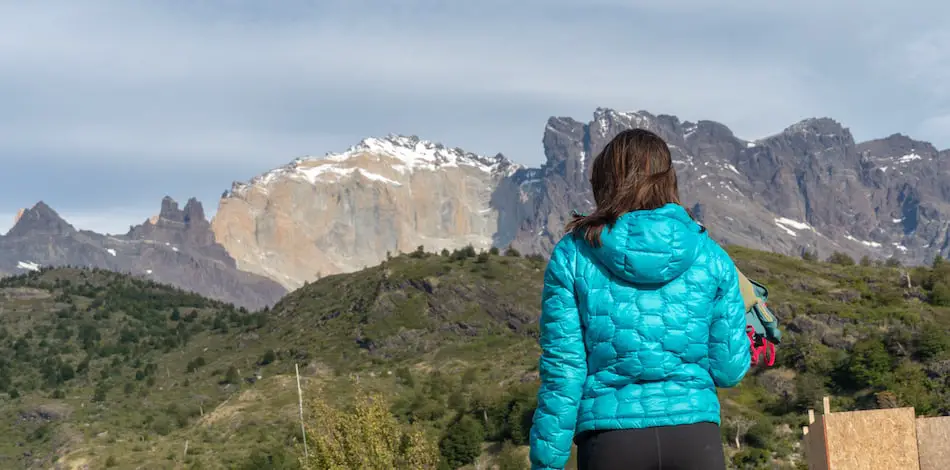
Finally, we get to the non-active layer. Basically, the non-active layer is what you pull on to keep you warm once you stop moving. Having a good non-active layer along is important not only for comfort; it can be a major factor in your safety.
When I got helicopter rescued off of a scramble in the Canadian Rockies, I had to spend an hour perched on the side of a cliff, waiting for my ride to show up. It was bitterly cold, and the wind was blasting at me. If not for the fact that I’d packed a cozy jacket, I would have been freezing. Since then, every single mountain I climb I make sure to bring an extra-warm layer with me, because I know how valuable they are in times of need.
So, what should you look for in a non-active layer? You want something that is both extremely warm and extremely packable, and when it comes to those criteria, nothing beats a good down jacket. Down will give you the best warmth-to-weight ratio of any material by a long shot.
Of course, down also has its own downsides (pun intended). It loses its insulating abilities when it gets wet, so you need to be careful of exposing it to any water. It can also be expensive and difficult to wash.
Because of this, I would also recommend looking at some of the synthetic down jackets that outdoor apparel companies have started making. They’re not as light as their down companions, but they often have their own advantages.
If you’re looking to buy a non-active layer:
- The Patagonia Down Sweater Hoody is what I’ve been using for the last three years and I swear by it. It’s warm, packable, and has good durability.
- Other good options include the Arc’teryx Cerium or the Rab Electron Pro
- If you don’t want to spend a bunch of money, some winter jackets have detachable inner shells that can be packed up to a decent size.
Active Mid Layer (For Winter Mountain Climbing)
As I said, if you’re climbing a mountain in the winter, I would also recommend bringing an active mid layer. This is another warm-yet-breathable sweater or jacket that you’ll wear while you’re on the move. It needs to be heavy enough to keep you insulated, but not so heavy that you sweat in it.
When you’re talking about active mid layers, there are a few good options on the market:
- The Patagonia Nano Air is considered the leader in the breathable insulation space
- The Black Diamond First Light Hoodie is another great contender
- The Mountain Hardwear Kor Strata
Lower Body

You don’t do as much layering on your lower body, simply because it’s harder to add/take off pairs of pants when you’ve got shoes on. This means that you need to pick the right pair of pants, because you’re going to be stuck with them all day.
There are two main layering systems that you see when mountain climbing:
- One-layer systems
- Two-layer systems
One-layer System
Like the name suggests, a one layer system is when you just have one pair of pants. I normally use this type of layering in the spring and summer, when I know that the temperature is going to remain mild. It has the advantage of being light and breathable.
For a one-layer system, hiking pants are by far the best option. Any outdoor apparel company will have a range of options to choose from. Personally, I like something that stretches well, dries quickly, and doesn’t have too many pockets or zippers. When you’re trying on the pants, make sure to do a few high steps to mimic the motion that you’ll use when walking uphill and make sure that it doesn’t impede your range of motion.
If you’re in a warmer climate, you might also want to wear shorts. I’m personally not a fan of this, because I find that I get cold too quickly, but this comes down to a matter of personal preference. I also live in Canada, so the temperature never really gets too hot here.
Some people like to wear zip-offs (pants that zip off into shorts) so that they can have a little more control over their layering. I personally hate zip-offs and I never wear them, because the zipper at the knees is really uncomfortable. If that’s your style, though, go for it (but know that I’m judging you).
Make sure to avoid denim, cotton, or other heavy materials that hold on to water.
There are dozens of hiking pant models out there, so I would just say use what works best for you. I’ve heard great things about the Patagonia Altvia Pant.
Two-Layer System
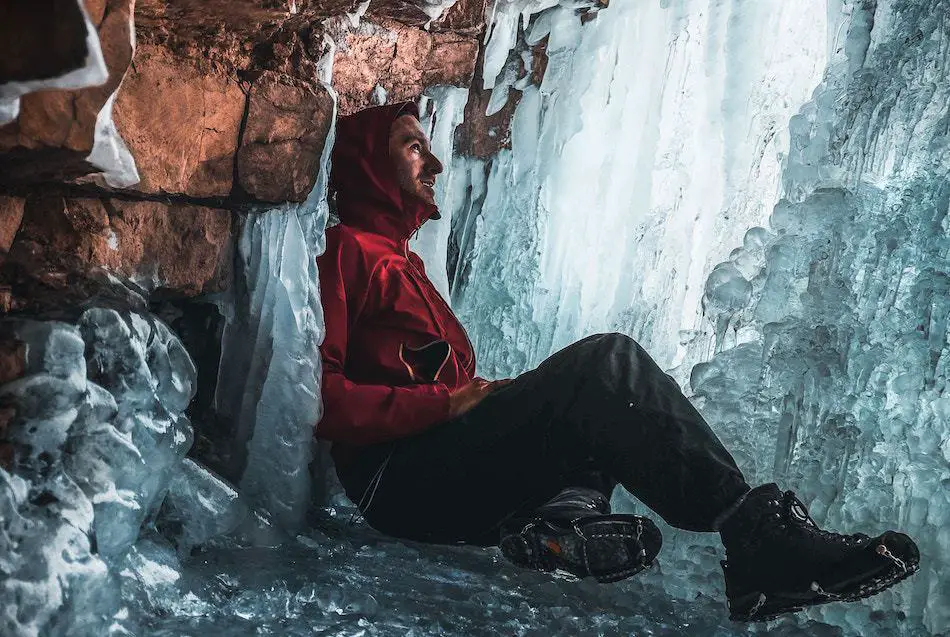
If you’re hiking in the winter, or even in the shoulder season, you might want to have a two-layer system to keep you warm and prevent snow from soaking your legs.
A two-layer system usually consists of a light pair of thermal underwear underneath an insulated, water-proof pair of pants. This helps your body insulate in colder temperatures, but you need to be careful; it’s easy to overdress and find yourself sweating all day.
If you have a pair of thermal underwear/snow pants that you go skiing with, I would recommend that you use those. If not, Merino Smartwool has some of the best baselayers on the market, and the Outdoor Research Cirque’s are considered the best insulated pants.
Feet
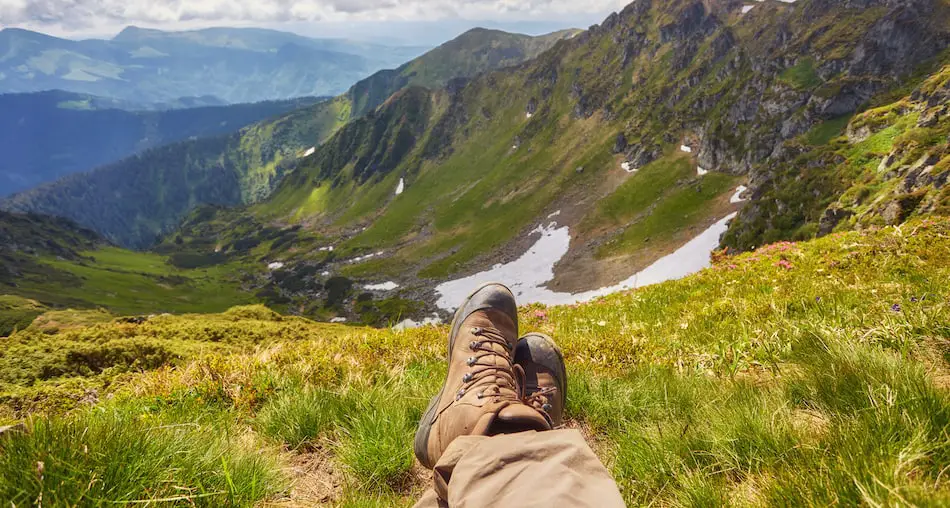
Choosing the right footwear is maybe the most important decision that you’re going to make when mountain climbing. You’ll have to take ten, twenty, or thirty thousand steps over the course of a single day, so any slight discomfort in your shoes is going to be amplified by a million.
When you’re shopping for footwear, you need to make sure to test how the shoe fits when you’re walking uphill and downhill (most outdoor apparel stores will have a ramp to help with this). When going uphill, you should make sure that your heel doesn’t lift too far off of the insole; when walking downhill, check that your toes don’t jam into the front of the shoe.
Another thing to consider is whether or not you want your shoes to be waterproof or not. I personally don’t wear waterproof boots, for the belief that my feet are going to get wet anyways (feet sweat a lot) and they’ll dry faster in a non-waterproof shoe.
There are four main categories of footwear that can be used for mountain climbing, three of which I recommend:
- Boots
- Trail Runners
- Approach Shoes
- Running Shoes
Boots
I will live and die by my conviction that you should wear a good, sturdy pair of boots when you’re mountain climbing. In recent years, there’s been a trend towards more hiking shoes and trail-runners because they’re lighter (and therefore tire you out less).
While that’s true, it also means that they provide less protection for your feet and ankles. Mountain climbing often requires that you deal with some pretty intense terrain: you’ll be crossing rivers, slogging through forests, and picking your way through boulder fields. Having a good pair of boots that prevents you from twisting an ankle or getting your foot crushed by a rock can be the difference between a successful summit and an emergency rescue.
I’m now in the third season with my Salomon Quest 4’s and I absolutely love them.
Trail Runners
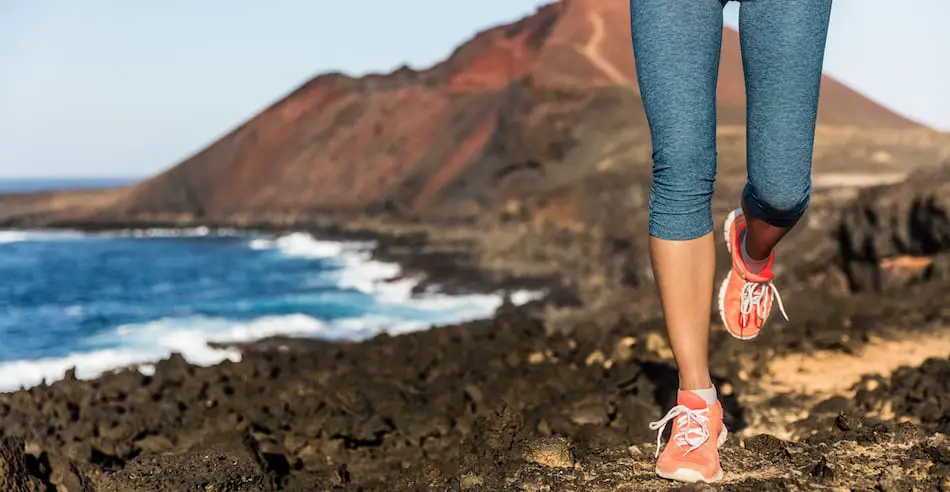
If you’re climbing a mountain that has a more well-defined trail, or you’re not as worried about rolling an ankle, trail runners or hiking shoes are a great option. These are shoes that still have solid treads and will provide you lots of grip, but won’t be as heavy as hiking boots. If speed and weight are important factors for you, these shoes might be the solution.
I don’t wear trail runners and so I can’t really recommend a pair, but anything from La Sportiva, Salomon, or The North Face should serve you well.
Approach Shoes
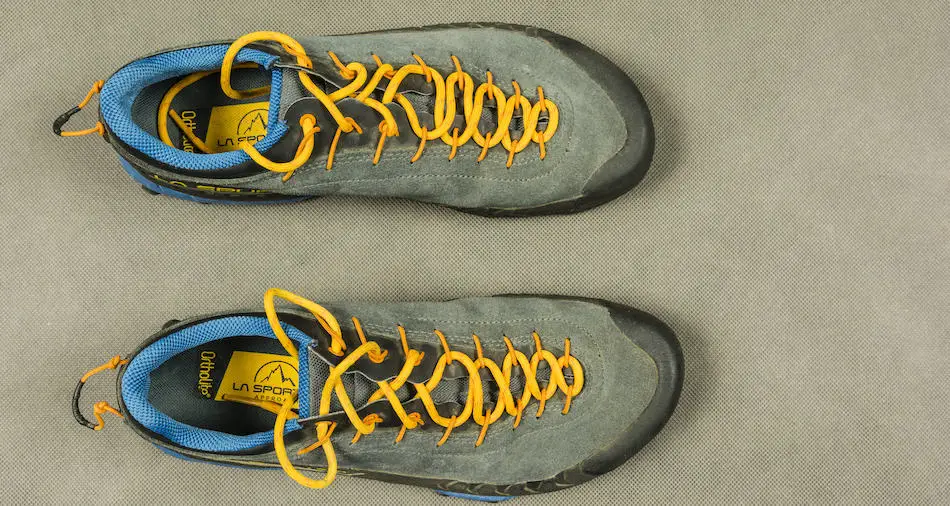
Approach shoes are a cross between hiking shoes and climbing shoes. They fit like a traditional runner, except they have more rubber at the toe and are specially designed for smearing on rock and gaining purchase on small footholds.
Although more common within the rock climbing world, approach shoes are a great option if the mountain you want to climb has any technical scrambling sections. From experience, I’ve found that mine are usually better on rock but not as good on dirt/mud, because the soles don’t have as much grip.
I use the Five Ten Guide Tennies and absolutely love them. The La Sportiva TX Guide is also highly renowned.
Running Shoes
Unless the mountain you’re climbing is highly non-technical, I wouldn’t recommend wearing running shoes. They don’t have the right sole for mountain climbing, and they don’t provide you any kind of ankle support.
No reccomendation, because you shouldn’t wear these
Socks
The right pair of socks can make or break your climb. Having a comfortable pair that keeps your feet cool and fits to the shape of your foot will make sure that you don’t get irritated and lower the chances of any blisters forming.
Any merino wool hiking sock out there will likely do. I personally like Columbia’s, because they’re not super expensive and you can buy them in packs.
Rain Gear
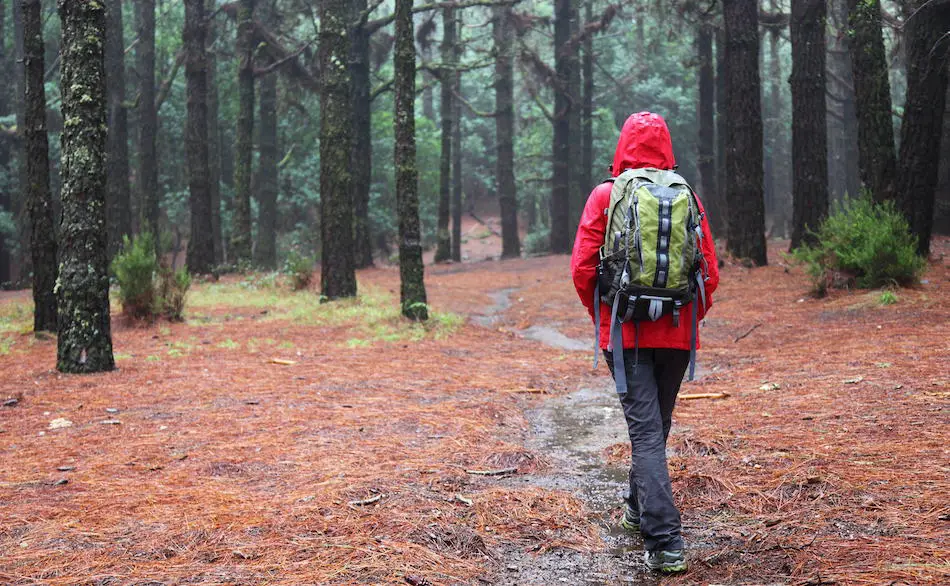
Weather conditions can change quickly in the mountains, and you need to make sure that you always have the right gear to keep you dry when a storm rolls in. Getting soaked isn’t just uncomfortable; it’s also unsafe and can lead to hypothermia if you spend too long in wet clothing.
The gear you pack depends on the weather forecast and your specific climate. Personally, I live in the Rockies, where it’s usually very dry but weather can change quickly. Because of this, I always carry my rain jacket with me, even if the forecast is showing a 0% chance of precipitation. On days when it’s calling for rain, I make sure to also pack my rain pants.
I would adjust your own preparation based on what you know of the area you’re climbing in. How often does it rain? Can the weather change suddenly? If it does rain, for how long will it last?
Every major outdoor apparel company sells rain gear, so I would take your pick of what you want. Try to get something that’s breathable, but make sure that it’s actually waterproof. Lots of companies will sell you jackets that, when faced with real rain will leak. If you have to choose between breathability and waterproofness, go with waterproofness.
Accessories

Now that we’ve covered all of the clothes, there are some other items that can be handy to have along.
Belt
Belts are obviously important for keeping your pants up. I would recommend staying away from leather and going with something that’s made out of fabric, as it’s going to be more flexible. A low-profile belt that fits comfortably under the waist straps of your backpack is best.
Hat
I would say always bring a hat when you go hiking, rain or shine. Any old baseball cap will do, although you should be prepared for it to get dirty/potentially blow away, so don’t bring anything that you’re too fond of.
Balaclava
Balaclavas or buffs can be great for keeping you warm when the temperatures drop. It’s a good idea to keep one tucked in your backpack in case you need it.
Crampons
Mountain climbing can sometimes take you to extreme environments where there will be snow on the ground year-round. You can check out my article here for more information about what type of crampons you should bring with you!
